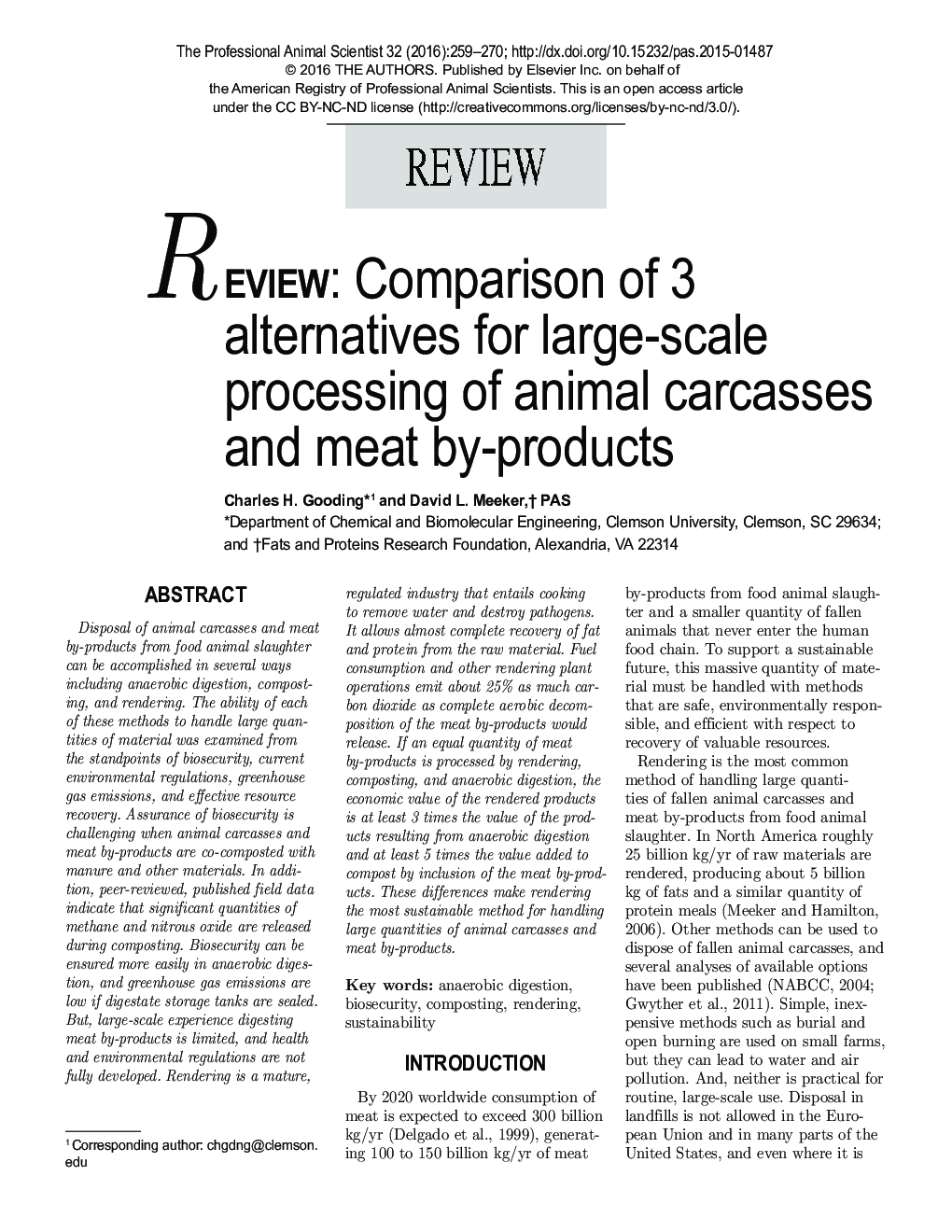| کد مقاله | کد نشریه | سال انتشار | مقاله انگلیسی | نسخه تمام متن |
|---|---|---|---|---|
| 10161698 | 1110342 | 2016 | 12 صفحه PDF | دانلود رایگان |
عنوان انگلیسی مقاله ISI
Review: Comparison of 3 alternatives for large-scale processing of animal carcasses and meat by-products
ترجمه فارسی عنوان
بررسی: مقایسه 3 گزینه برای پردازش در مقیاس بزرگ لاشه حیوانات و گوشت فرآورده های گوشتی
دانلود مقاله + سفارش ترجمه
دانلود مقاله ISI انگلیسی
رایگان برای ایرانیان
کلمات کلیدی
هضم بی هوازی امنیت غذایی، کمپوست تفسیر، پایداری،
ترجمه چکیده
دفع لاشه های حیوانی و گوشت های فرعی از کشتار حیوانات می تواند در چندین راه از جمله هضم بی هوازی، کمپوست و رندر انجام شود. توانایی هر یک از این روش ها برای مقابله با مقادیر زیاد مواد از دیدگاه های بیولوژیک، مقررات زیست محیطی فعلی، انتشار گازهای گلخانه ای، و بازیابی منابع موثر مورد بررسی قرار گرفت. اطمینان از ایمنی بیولوژیک هنگامی که لاشه های حیوانی و محصولات گوشتی با کود و سایر مواد کامپوزیت می شوند چالش برانگیز است. علاوه بر این، داده های میدانی منتشر شده توسط همکاران، نشان می دهد که در طول کمپوست مقدار قابل توجهی از متان و اکسید نیتروژن آزاد می شود. در صورت هضم بی هوازی به راحتی می توان امنیت بیولوژیکی را تضمین کرد، و اگر مخازن ذخیره سازی هضم شده مهر و موم شده باشند، انتشار گازهای گلخانه ای کم است. اما، تجربه بزرگ در زمینه گوارش گوشت های فرعی محدود است و مقررات بهداشتی و محیط زیست به طور کامل توسعه نمی یابد. رندر یک صنعت بالغ، تنظیم شده است که مستلزم پخت و پز برای حذف آب و تخریب پاتوژن ها است. این اجازه می دهد تقریبا کامل بازیابی چربی و پروتئین از مواد خام است. مصرف سوخت و دیگر کارخانه های رندرینگ حدود 25 درصد دی اکسید کربن را به عنوان انحلال کامل هوازی گوگرد تولید می کنند. اگر مقدار مساوی از محصولات گوشتی توسط رندر، کمپوست و هضم بی هوازی پردازش می شود، ارزش اقتصادی محصولات ارائه شده حداقل 3 برابر ارزش محصولات حاصل از هضم بی هوازی است و حداقل 5 برابر مقدار اضافه شده به کمپوست را با افزودن گوشت فرعی. این تفاوت ها باعث می شود که روش پایدار ترین روش برای مقابله با مقادیر زیادی از لاشه های حیوانی و گوشت های فرعی باشد.
موضوعات مرتبط
علوم زیستی و بیوفناوری
علوم کشاورزی و بیولوژیک
علوم دامی و جانورشناسی
چکیده انگلیسی
Disposal of animal carcasses and meat by-products from food animal slaughter can be accomplished in several ways including anaerobic digestion, composting, and rendering. The ability of each of these methods to handle large quantities of material was examined from the standpoints of biosecurity, current environmental regulations, greenhouse gas emissions, and effective resource recovery. Assurance of biosecurity is challenging when animal carcasses and meat by-products are co-composted with manure and other materials. In addition, peer-reviewed, published field data indicate that significant quantities of methane and nitrous oxide are released during composting. Biosecurity can be ensured more easily in anaerobic digestion, and greenhouse gas emissions are low if digestate storage tanks are sealed. But, large-scale experience digesting meat by-products is limited, and health and environmental regulations are not fully developed. Rendering is a mature, regulated industry that entails cooking to remove water and destroy pathogens. It allows almost complete recovery of fat and protein from the raw material. Fuel consumption and other rendering plant operations emit about 25% as much carbon dioxide as complete aerobic decomposition of the meat by-products would release. If an equal quantity of meat by-products is processed by rendering, composting, and anaerobic digestion, the economic value of the rendered products is at least 3 times the value of the products resulting from anaerobic digestion and at least 5 times the value added to compost by inclusion of the meat by-products. These differences make rendering the most sustainable method for handling large quantities of animal carcasses and meat by-products.
ناشر
Database: Elsevier - ScienceDirect (ساینس دایرکت)
Journal: The Professional Animal Scientist - Volume 32, Issue 3, June 2016, Pages 259-270
Journal: The Professional Animal Scientist - Volume 32, Issue 3, June 2016, Pages 259-270
نویسندگان
Charles H. Gooding, David L. PAS,
